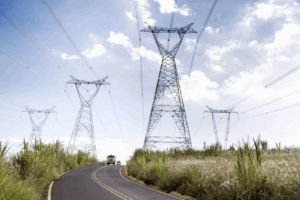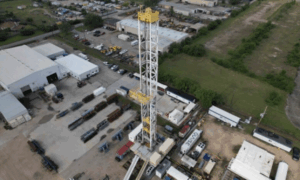This month, we’re discussing some good news (about the latest transmission line project in the country), some bad news (related to federal policy) and some really interesting technology development news involving vaporizing rocks.

Credit: Hitachi Energy
Transmission!
Invenergy, the Chicago based developer (and friend of Evergreen’s) announced new investment commitments as part of their Grain Belt Express high voltage transmission line moving forward.
Transmission is extremely hard to get approved and built – I worked on transmission policy while I was at the Department of Energy in 2012, and Grain Belt Express was a 3-inch binder on my desk and had been under development for several years at that point, so it is very exciting to see additional progress here. Regardless of what flavor of electrons you prefer, we need a lot more transmission to effectively meet growing energy demand in the US (and we need it even more if we’re going to decarbonize). To that end, here’s an interview Invenergy CEO Michael Polsky gave on Fox Business highlighting how investments in transmission are an important part of America’s energy agenda.

Credit: Somodevilla/Getty Images/Newsweek
Asleep At The Switch
The House passed their version of the Big Beautiful Bill reconciliation package in May by a single vote. To be fair it sounds like one dude was going to vote for it but fell asleep because they were up all night; on the other hand, that dude is Republican Congressman Andrew Garbarino, who led the Republican opposition to cutting clean energy tax credits in the months prior to the legislation passing.
The theme from this bill is a backdoor repeal of the Inflation Reduction Act. Backdoor because some of the credits would stay in place, but would be ramped down or their timelines significantly shortened, in combination with very, very aggressive rules around what components cannot be sourced from China. So in practice it would likely function as something very close to a repeal. So you could get a tax credit for your solar project, but only if you start building it in the next couple months, and you don’t have any screws or parts that were made in southeast Asia essentially – good luck! Also all the consumer facing tax credits (for electric vehicles, energy efficiency, and home electrification) are quickly ramped down and/or scaled back.
Now, the Senate is considering their own version of this bill – their current draft is still terrible for the clean energy industry, and specifically targets wind and solar, although is probably less terrible than the House draft, as their version of the supply chain sourcing rules might be more workable (on the other hand, they may not be). It also maintains support for some low carbon sources (nuclear and geothermal), because that’s what the current Energy Secretary thinks is important.
What actually passes at the end of the day (and is agreed upon in conference committee) is still up in the air, but it seems clear that it will be very negative for residential customers and wind and solar development. Ironically, this may significantly decrease the amount of new generation being brought onto the grid (since almost everything in the queue is wind, solar and batteries), just as the US sees the largest load growth in decades.
In the meantime, between tariffs and the uncertainty from this legislation, a huge number of projects have been cancelled so far this year, as reported by The Washington Post.


Credit: DrillingContractor.org
Blasting Rocks
Geothermal startup Quaise has the first hybrid drilling rig set up in partnership with oil and gas drilling company Nabors Industries in Houston (who is also an investor in the company). This drilling companies traditional mechanical techniques with something new called millimeter wave drilling. In this new approach, the rock is vaporized with radio waves, and then the ash gets pulled out in a gas stream, and the reaction creates its own casing in the ground. This hybrid approach would start off with a traditional mechanical approach and use the millimeter wave approach to go much deeper than traditional approaches are cost-effective, where there’s much more heat, which translates to being able to produce much more power out of the same well, which can bring down costs significantly. Sort of the drilling equivalent of sharks with frickin’ laser beams on their heads if you ask me. I am excited about the potential of this approach, both because of what it could unlock technologically, and because of the go-to market, leveraging conventional drilling expertise, equipment, and partnership. As hopefully the proverb will state in the future “the journey of a 10 mile-deep drilling initiative starts with the first 10 feet drilled in a pilot project.”
Other News
The Supreme Court’s recent decision on the National Environmental Policy Act could have major implications for permitting energy projects (essentially they clarified that you have to look at the thing in question, but not the potential indirect impacts of the thing).
Microsoft expanded on a deal with the Swedish heat plant operator Exergi for carbon removal from bioenergy with carbon capture and storage (or BECCS). Microsoft also announced a deal with biochar producer Exomad Green for over a million tons of removal, which is the largest carbon removal deal to date.
A suite of bills that passed the Texas State Senate that would have significantly reduced or stopped the renewables industry in the state died quietly in the Texas House – a victory for the renewables industry in a year where they are likely to have significant losses.